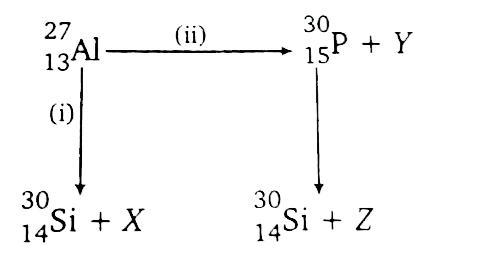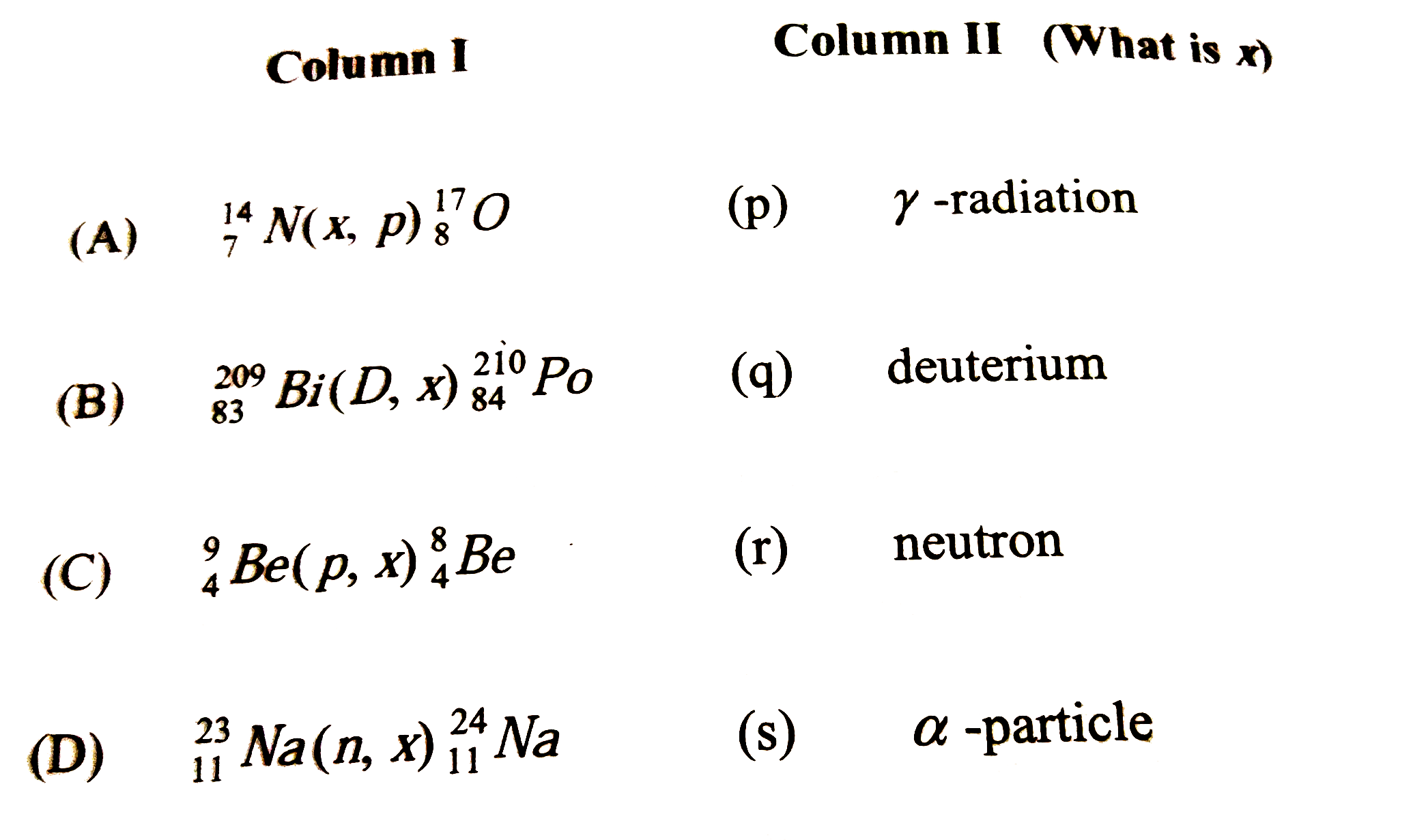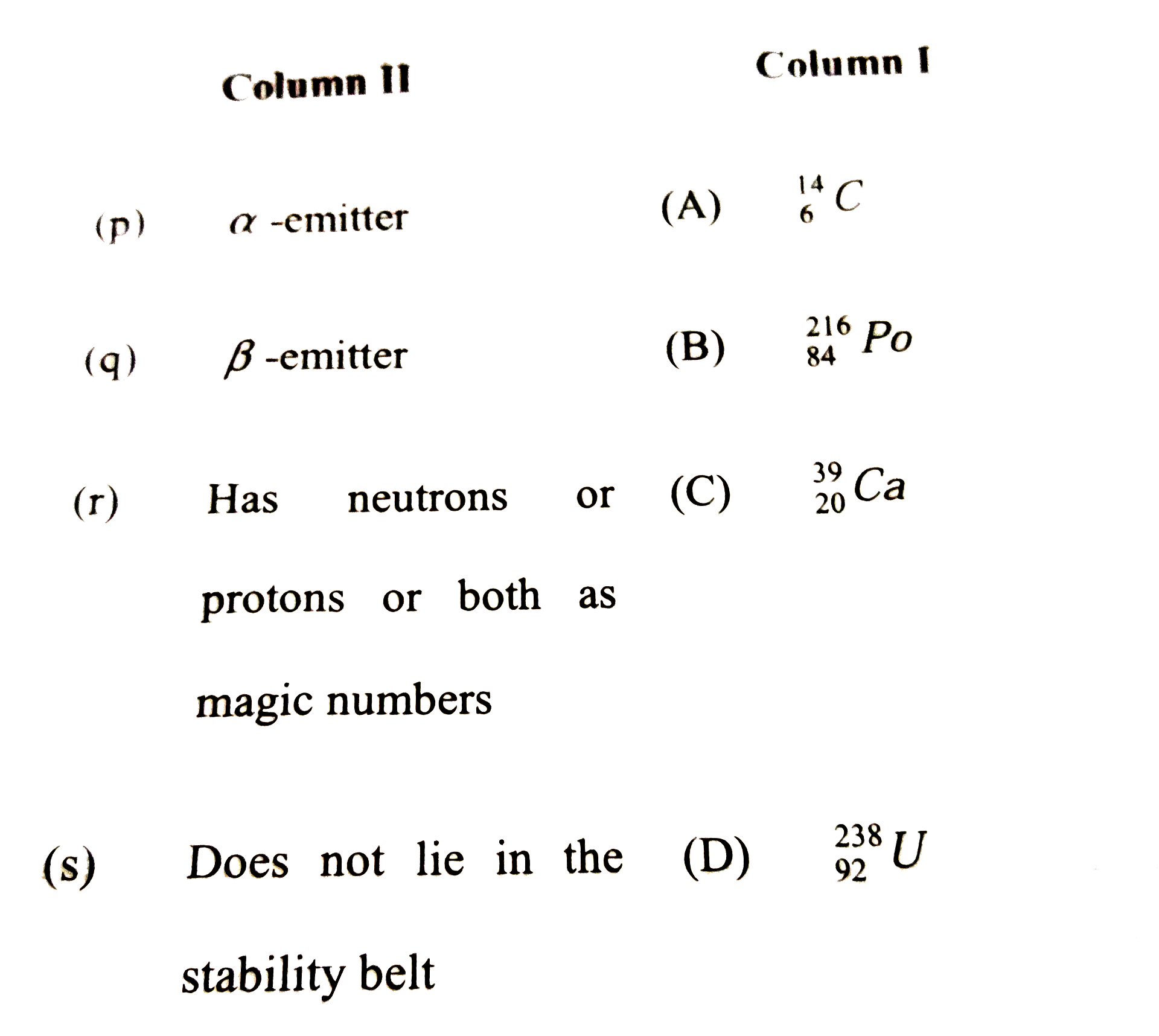JEE SECTION (Reasoning type questions) from UNIVERSAL BOOK DEPOT 1960 CHEMISTRY (HINGLISH) NUCLEAR CHEMISTRY for Class 12
| Class 12 | CHEMISTRY |
| Chapter | NUCLEAR CHEMISTRY |
| UNIVERSAL BOOK DEPOT 1960 CHEMISTRY (HINGLISH) | JEE SECTION (Reasoning type questions) |
| Medium | English |
| Academic Year | 2023-2024 |
Question 30
Statement 1 : Proton -proton electrostatic repulsions begin to overcome attractive forces involving protons and neutrons in heavier nuclides
Statement 2 : The plot of atomic number (y-axis) veruse number of neutrons (x-axis) for stable nuclei shows a curvature towards x-axis from the line of 45∘ slope as the atomic number is increased. View SolutionQuestion 31
Statement 1 : Hydrogen bomb involves not only fusion but also fission reactions to start the fusion whereas atom bomb involves only fission.
Statement 2 : Though energy liberated per fusion is smaller than energy liberated per fission, yet hydrogen bomb is more powerful than atom bomb.View SolutionQuestion 33
Carbon-14 is used to determine the age of organic material. The procedure is based on the formation of .14C by neutron capture in the upper atmosphere.
.147N+.10n→.146C+.1n1
.14C is absorbed by living organisms during photosynthesis. The .14C content is constant in living organism once the plant or animal dies, the uptake of carbon dioxide by it ceases and the level of .14C in the dead being, falls due to the decay which .14C undergoes.
.146C→.147N+β−
The half-life period of .14C is 5770 years. The decay constant (λ) can be calculated by using the following formula λ=0.693t1/2.
The comparison of the β− activity of the dead matter with that of the carbon still in circulation enable measurement of the period of the isolation of the material from the living cycle. The method however, ceases to be accurate over periods longer than 30,000 years. The proportion of .14C to .12C in living matter is 1:1012.
Which of the following option is correctView SolutionQuestion 34
Carbon 14 is used to determine the age of organic material. The procerdure is based on the formation of .14C by neutron capture in the upper atmosphere.
.147N+.10n→.146C+.1n1
.14C is abosorbed by living organisms during phostosythesis. The .14C content is constant in living organisms once the plant or animal dies, the uptake of carbon dioxide by it ceases and the level of .14C in the dead being, falls due to the decay which .14C undergoes.
.146C→.147C+β−
The half-life period of .14C is 5770 years. The decay constant (λ) can be calculated by using the following formula λ=0.693t1/2
The comparison fo the β− activity fo the dead matter with that of the carbon still in circulation enables measurement of the period of the isolation the materail form the living cycle. The method however, ceases to be accurate ever periods longer than 30,000 years. The proportaion of .14C to .12C living matter is 1:1012.
What should be the age of fossil for meainingful determination of its age?View SolutionQuestion 35
Carbon 14 is used to determine the age of organic material. The procerdure is based on the formation of .14C by neutron capture in the upper atmosphere.
.147N+.10n→.146C+.1n1
.14C is abosorbed by living organisms during phostosythesis. The .14C content is constant in living organisms once the plant or animal dies, the uptake of carbon dioxide by it ceases and the level of .14C in the dead being, falls due to the decay which .14C undergoes.
.146C→.147C+β−
The half-life period of .14C is 5770 years. The decay constant (λ) can be calculated by using the following formula λ=0.693t1/2
The comparison fo the β− activity fo the dead matter with that of the carbon still in circulation enables measurement of the period of the isolation the materail form the living cycle. The method however, ceases to be accurate ever periods longer than 30,000 years. The proportaion of .14C to .12C living matter is 1:1012.
A nulcear explosion has taken place leading to increases in conventration of ^(14)C in nearly areas. ^(14)C concentration is C1 in nearby areas and C2 in areas far away. If the age of the fossil is detemined to be T1 and T2 at the places respectively, then:View SolutionQuestion 36
The emission of an αoraβ particle by a radioactive element forms a new element. However, successive emission of some αorβ- particles may give rise to an isotope or an isobar of the original element. In many cases, positron emission or K− electron capture takes place, leading again to the formuation of new elements, alongwith the emission of neutrinos or antineutrinos. These emission also change the neutron/proton (n/p) ratio so that they give rise to stable isotopes which lie in the stability belt. However, in any disintegration reaction, the law of conservation of atomic number and mass number is always obeyed and this helps us to calculate the number of αandβ− particles emitted in the reaction.
The number of α−andβ− particle emitted in nuclear reaction .90Th288→.83Bi212 are respectivelyView SolutionQuestion 37
The emission of an αoraβ particle by a radioactive element forms a new element. However, successive emission of some αorβ- particles may give rise to an isotope or an isobar of the original element. In many cases, positron emission or K− electron capture takes place, leading again to the formuation of new elements, alongwith the emission of neutrinos or antineutrinos. These emission also change the neutron/proton (n/p) ratio so that they give rise to stable isotopes which lie in the stability belt. However, in any disintegration reaction, the law of conservation of atomic number and mass number is always obeyed and this helps us to calculate the number of αandβ− particles emitted in the reaction.
In the above sequence of reactions, the elements which are isotopes of each other areView SolutionQuestion 38
The emission of an αoraβ particle by a radioactive element forms a new element. However, successive emission of some αorβ- particles may give rise to an isotope or an isobar of the original element. In many cases, positron emission or K− electron capture takes place, leading again to the formuation of new elements, alongwith the emission of neutrinos or antineutrinos. These emission also change the neutron/proton (n/p) ratio so that they give rise to stable isotopes which lie in the stability belt. However, in any disintegration reaction, the law of conservation of atomic number and mass number is always obeyed and this helps us to calculate the number of αandβ− particles emitted in the reaction.
A radioactive element X emits 3α,1βand1γ−particles and forms .76Y235. Element X isView SolutionQuestion 39
The emission of an αoraβ particle by a radioactive element forms a new element. However, successive emission of some αorβ- particles may give rise to an isotope or an isobar of the original element. In many cases, positron emission or K− electron capture takes place, leading again to the formuation of new elements, alongwith the emission of neutrinos or antineutrinos. These emission also change the neutron/proton (n/p) ratio so that they give rise to stable isotopes which lie in the stability belt. However, in any disintegration reaction, the law of conservation of atomic number and mass number is always obeyed and this helps us to calculate the number of αandβ− particles emitted in the reaction.
In the nuclear reaction Po−α−−→Pb−β−−→Bi, knowing that Bi belongs to Group 15, Po will belong to GroupView SolutionQuestion 40
The emission of an αoraβ particle by a radioactive element forms a new element. However, successive emission of some αorβ- particles may give rise to an isotope or an isobar of the original element. In many cases, positron emission or K− electron capture takes place, leading again to the formuation of new elements, alongwith the emission of neutrinos or antineutrinos. These emission also change the neutron/proton (n/p) ratio so that they give rise to stable isotopes which lie in the stability belt. However, in any disintegration reaction, the law of conservation of atomic number and mass number is always obeyed and this helps us to calculate the number of αandβ− particles emitted in the reaction.
Positron emission result in View SolutionQuestion 41
In the artificial transmutation of elements, Alchemists was interested to convert basic metals like iron into precious metals like gold. A number of subatomic particles was used as projectiles to hit the nuclei after accelerating these particles in cyclotron. The ejectiles were also generally some subatomic particles or in some cases, only γ-radiation were emitted. These nuclear reactions are generally represented by Bethe's notation. In certain cases it is observed that artificial transmutation of a stable nucleus gives a radioisotope which disintegrates by itself like a natural radioactive element. The phenomenon is called induced radioactivity.
Which one of the following notations shows the product incorrectly View SolutionQuestion 42
In the artificial transmutation of elements, Alchemists was interested to convert basic metals like iron into precious metals like gold. A number of subatomic particles was used as projectiles to hit the nuclei after accelerating these particles in cyclotron. The ejectiles were also generally some subatomic particles or in some cases, only γ-radiation were emitted. These nuclear reactions are generally represented by Bethe's notation. In certain cases it is observed that artificial transmutation of a stable nucleus gives a radioisotope which disintegrates by itself like a natural radioactive element. The phenomenon is called induced radioactivity.
What is X in the following nuclear reaction
.147N+.11H→.158O+'X'View SolutionQuestion 43
In the artificial transmutation of elements, Alchemists was interested to convert basic metals like iron into precious metals like gold. A number of subatomic particles was used as projectiles to hit the nuclei after accelerating these particles in cyclotron. The ejectiles were also generally some subatomic particles or in some cases, only γ-radiation were emitted. These nuclear reactions are generally represented by Bethe's notation. In certain cases it is observed that artificial transmutation of a stable nucleus gives a radioisotope which disintegrates by itself like a natural radioactive element. The phenomenon is called induced radioactivity.
The following nuclear transmutation
.11Na23+.1H1→.12Mg23+.0n1 belongs toView SolutionQuestion 44
In the artificial transmutation of elements, Alchemists was interested to convert basic metals like iron into precious metals like gold. A number of subatomic particles was used as projectiles to hit the nuclei after accelerating these particles in cyclotron. The ejectiles were also generally some subatomic particles or in some cases, only γ-radiation were emitted. These nuclear reactions are generally represented by Bethe's notation. In certain cases it is observed that artificial transmutation of a stable nucleus gives a radioisotope which disintegrates by itself like a natural radioactive element. The phenomenon is called induced radioactivity.
Which one of the following is not an example of induced radioactivity View SolutionQuestion 49
A very small amount of radioactive isotope of .213Pb was mixed with a non-radioactive lead salt containing 0.01 g of Pb (atomic mass 207). The whole lead was brought into solution and lead chromate was precipitated by addition of a soluble chromate. Evaporation of 10cm3 of the supernature liquid gave a residue having a radioactivity 1/24000 of that of the original quantity of .213Pb. If the solubility of lead chromate is x×10−y mol dm−3, then value of x is View Solution
All Exercises from UNIVERSAL BOOK DEPOT 1960 CHEMISTRY (HINGLISH) Class 12 CHEMISTRY NUCLEAR CHEMISTRY
- ORDINARY THINKING
- ORDINARY THINKING (ARTIFICIAL TRANSMUTATION )
- ORDINARY THINKING (CAUSES OF RADIOACTIVITY AND GROUP DISPLACEMENT LAW)
- ORDINARY THINKING (ISOTOPES-ISOTONES AND NUCLEAR ISOMERS)
- ORDINARY THINKING (RADIOACTIVITY AND `ALPHA, BETA` AND `GAMMA`-RAYS)
- ORDINARY THINKING (RATE OF DECAY AND HALF - LIFE)
- CRITICAL THINKING (OBJECTIVE QUESTION)
- JEE SECTION (COMPREHENSION TYPE QUESTIONS)
- JEE SECTION (INTEGER TYPE QUESTIONS)
- JEE SECTION (MATRIX MATCH TYPE QUESTIONS)
- JEE SECTION (MORE THAN ONE CHOICE CORRECT ANSWER)
- JEE SECTION (ONLY ONE CHOICE CORRECT ANSWER)
- JEE SECTION (REASONING TYPE QUESTIONS)


